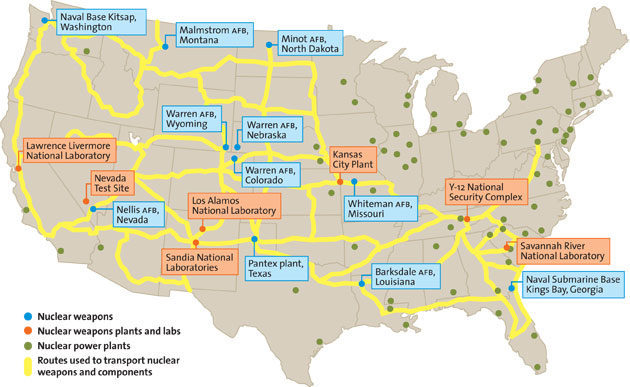General Discussion
Related: Editorials & Other Articles, Issue Forums, Alliance Forums, Region ForumsOn a Highway Near You: The Department of Energy’s Fleet of Nondescript Nuclear Transport Trucks
On a Highway Near You: The Department of Energy’s Fleet of Nondescript Nuclear Transport Trucks

As you weave through interstate traffic, you’re unlikely to notice another plain-looking Peterbilt tractor-trailer rolling along in the right-hand lane. The government plates and array of antennas jutting from the cab’s roof would hardly register. You’d have no idea that inside the cab an armed federal agent operates a host of electronic countermeasures to keep outsiders from accessing his heavily armored cargo: a nuclear warhead with enough destructive power to level downtown San Francisco.
That’s the way the Office of Secure Transportation (OST) wants it. At a cost of $250 million a year, nearly 600 couriers employed by this secretive agency within the US Department of Energy use some of the nation’s busiest roads to move America’s radioactive material wherever it needs to go—from a variety of labs, reactors and military bases, to the nation’s Pantex bomb-assembly plant in Amarillo, Texas, to the Savannah River facility. Most of the shipments are bombs or weapon components; some are radioactive metals for research or fuel for Navy ships and submarines. The shipments are on the move about once a week.
The OST’s operations are an open secret, and much about them can be gleaned from unclassified sources in the public domain. Yet hiding nukes in plain sight, and rolling them through major metropolises like Atlanta, Denver, and LA, raises a slew of security and environmental concerns, from theft to terrorist attack to radioactive spills. “Any time you put nuclear weapons and materials on the highway, you create security risks,” says Tom Clements, a nuclear security watchdog for the nonprofit environmental group Friends of the Earth. “The shipments are part of the threat to all of us by the nuclear complex.” To highlight those risks, his and another group, the Georgia-based Nuclear Watch South, have made a pastime of pursuing and photographing OST convoys.
…
The OST doesn’t employ your typical truck-stop 18-wheeler jockeys; the agency seeks to hire military veterans, particularly ex-special-operations forces. Besides contending with “irregular hours, personal risks, and exposure to inclement weather,” agents “may be called upon to use deadly force if necessary to prevent the theft, sabotage or takeover of protected materials by unauthorized persons.” At a small outpost in Ft. Smith, Arkansas—the Army base where Elvis was inducted and got his famous haircut—the prospective agents are trained in close-quarters battle, tactical shooting, physical fitness, and shifting smoothly through the gears of a tractor-trailer.
In 2010, DOE inspectors were tipped off to alcohol abuse among the truckers. They identified 16 alcohol-related incidents between 2007 and 2009, including one in which agents were detained by local police at a bar after they’d stopped for the night with their atomic payload. After several agents and contractors were caught bringing unauthorized guns on training missions in Nevada between 2001 and 2004, DOE inspectors determined that “firearms policies and procedures were systematically violated.” One OST agent in Texas pled guilty in 2006 to trying to sell body armor, rifle scopes, machine gun components, and other assault gear he’d pilfered on the job.
There have also been accidents. In 1996, a driver flipped his trailer on a two-lane Nebraska hill road after a freak ice storm, sending authorities scrambling to secure its payload of two nuclear bombs and return them to a nearby Air Force base. In 2003, two trucks operated by private contractors had rollover accidents in Montana and Tennessee while hauling uranium hexafluoride, a compound use to enrich reactor and bomb fuel. (DOE apparently uses some contractors for “low-risk” shipments, while high-security hauling is reserved for OST truckers). In June 2004, on I-26 near Asheville, North Carolina, a truck bound for the Savannah River Site leaked “less than a pint” of uranyl nitrate—liquefied yellowcake uranium, which can be used to produce bomb components.
http://publicintelligence.net/nuclear-eighteen-wheelers/
Response to The Straight Story (Original post)
Tesha This message was self-deleted by its author.
Odin2005
(53,521 posts)Major Hogwash
(17,656 posts)I didn't know they traveled north from Pocatello in Idaho to Dillon in Montana.
That is a pretty hairy route to take in the winter.
Ron Green
(9,822 posts)...... nineteen sixties.
A HERETIC I AM
(24,368 posts)They aren't so non-descript, really. In fact, they kind of stand out because of how purposefully plain they are. Not to mention painted in that battleship blue/grey and accompanied by at least two dark painted Suburbans with blacked out windows - but not so much that you can't see the blue and red E-lights in the windows.
I had a chat with a Naval weapons guy once that was familiar with these convoys and asked him if they ever got hassled by an unknowing Highway Patrolman. He told me that more than once, a cop with an attitude that tried to pull the convoy over was left hogtied and gagged in his squad car and a phone call to his supervisor was made as to where he was and that they should go release him.
They don't stop at weigh stations, see. And some Troopers think they are somebodies somebody.